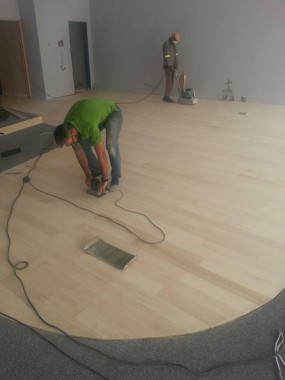Our Story
The Floor Boss is a Johannesburg based company specializing in the installation and refurbishment of wooden floors across residential and commercial properties. Our team has years of combined experience within the wooden flooring industry. We have an excellent reputation throughout the greater Gauteng Area, having completed many projects, large and small.
We believe that working with wood is a natural art form where attention to detail, know how and passion is integral to bringing out the true beauty of this natural material.

Why go for a wooden Floor
ADVANTAGES OF WOODEN FLOORS:
With all the different flooring options available, hardwood flooring may seem like an expensive option. However, hardwood flooring remains the best choice in having a space that is safe and clean with low maintenance. When you consider the overall life of a hardwood floor, the benefits of wood flooring outweigh the initial cost.
Safe & Clean
One of the biggest advantages of hardwood floors is that hardwood flooring is a more sanitary option than other floor types. When thinking about carpet vs. hardwood, a good amount of dust, germs and other debris get absorbed into the carpet fibers. With hardwood flooring, there is no place for debris to hide, making for a healthier, safer living environment, especially for allergy sufferers.
Low Maintenance
Generally, hardwood floors cost more than carpeted floors, but they also require less maintenance. Because hardwood floors are typically sealed surfaces with a protective layer of finish, wood floors are more stain resistant than other types of flooring.
One of the benefits of hardwood floors is that they can be repaired and refinished. Hardwood floors do get scraped, scratched, scuffed, dented and damaged – especially in high traffic areas. However, wood flooring can most often simply be sanded, smoothed and refinished. It is rarely necessary to replace a wood floor.
Sustainable
Another advantage of hardwood floors is the environmental factor. Wood flooring is the most abundantly renewable flooring material available. The U.S. Forest Service states that the annual net growth for hardwoods is greater than the average annual removal rate. This means that trees are growing faster than they are being used today.
Wood floors also use less water and energy to produce and can be recycled at the end of their life cycle, making it an extremely sustainable product. Considering the differences in producing carpet vs. hardwood, carpet uses more synthetic materials to produce and is treated with more chemicals than hardwood. Also, hardwood not only brings beauty and value to a home, but it can truly last a lifetime while carpet needs to be replaced every 10-15 years.
Unsurpassed Beauty & Value
Probably the biggest benefit of hardwood is its unique and beautiful look. Hardwood is one of the oldest flooring materials there is, and it never goes out of style. Because of the large variety of trees and wood types, a world of colors, consistencies, designs, and grain patterns are available.
Hardwood floors also increase the value of a house or property. Whereas many new homeowners will remove carpeting when they buy a house, a gorgeous hardwood floor is usually a reason why a house is bought.
THE PROCESS – WHAT TO EXPECT:
Step 1: Preparing the room
This task can take more time than sanding the floor. All furniture ad wall hangings must be removed. All carpeting, under padding and installations will be pulled up. To contain the dust that will be generated by sanding, we seal off openings to other parts of the house and secure drop sheets where needed. We also make sure all lose blocks are glued. The glueing of loose blocks can add extra time and cost to the project.
Step 2: Floor sanding
Floor sanding is done by industrial sanding machines. Some handwork may be necessary in places that are inaccessible to power machines. Wood floors need to be sanded three or four times, each with a finer grit of sandpaper. The number of passes and the sandpaper to use will depend on the condition of your floor. A floor that is covered with paint or glue will need more passes with lower grit sandpaper than a level floor in good condition. The first pass should remove almost all of the old finish and level the floor. The subsequent passes will remove any remaining finish and smooth out roughness and scratch marks. Electric edger’s are used for sanding these edges of the floor or it may be done by hand depending on the area.
Step 3: Sealing
We use a Matt, Gloss or Satin finish for your floor. It is important that the floor must remain sealed, and protected. The sealant we use is a deep penetrating sealer.
Step 4: Finishing
Finishing a floor takes about three coats of sealant applied over a period of several hours. After the floors are sanded and cleaned the first coat of sealant is applied. Each coat must be allowed to dry and when sufficiently dry, the floor will be lightly sanded again. Subsequent coats are applied and allowed to dry leaving a beautiful hardwood floor that will last for years.